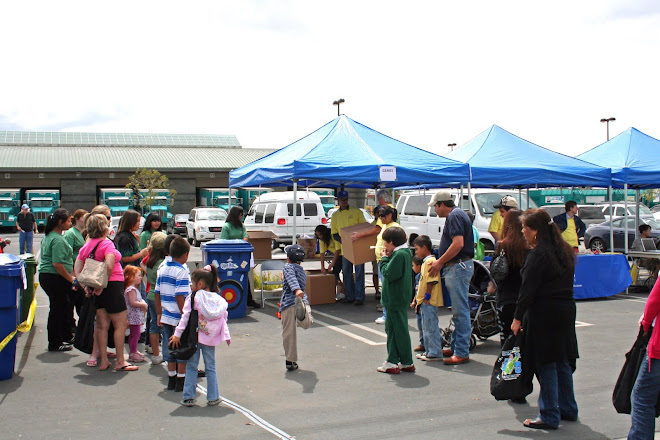Record Attendance with more than 3,000 at the West LA Open House!

An incredible turnout for reducing, reusing and recycling in the City of Los Angeles!
Families with children and residents visited Sanitation's West Los Angeles District Yard by the hundreds for the chance to meet with truck operators and learn how the city collects and removes its trash, recyclables

and yard trimmings.
A favorite among parents and children, Mr. Recycle gave high fives for recycling and received lots of attention and appreciation!
Dates
Saturday, April 28, 2012 - 9:00 a.m. to 2:30 p.m.
East Valley District Yard
11050 Pendleton Street, Sun Valley, CA 91352
Saturday, May 19, 2012 - 9:00 a.m. to 2:30 p.m.
West Valley District Yard
8840 Vanalden Avenue, Northridge, CA 91324
Saturday, June 2, 2012 - 9:00 a.m. to 2:30 p.m.
North Central District Yard
452 N. San Fernando Road, Los Angeles, CA 90031
Saturday, June 9, 2012 - 9:00 a.m. to 2:30 p.m.
South Los Angeles District Yard at The Expo Center
3990 Menlo Ave., Los Angeles, CA 90037
(NE corner of Martin Luther King Blvd & Vermont Ave.)
Saturday, June 23, 2012 - 9:00 a.m. to 2:30 p.m.
Harbor District Yard
1400 N. Gaffey Street, San Pedro, CA 90731
Saturday, June 30, 2012 - 9:00 a.m. to 2:30 p.m.
West Los Angeles District Yard
2027 Stoner Avenue, Los Angeles, CA 90025
Background
State of California Assembly Bill 939 (AB 939) was signed into law in 1989, establishing a new environmental direction for waste management in the state with the creation of the California Integrated Waste Management Board (CIWMB) and a new mandate for local jurisdictions to meet waste diversion goals to minimize the waste of potentially valuable resources and maximize recycling.
AB 939 mandated that the City of Los Angeles, and all cities across the state, meet solid waste diversion goals of 25 percent by 1995 and 50 percent by 2000. To guide the city's effort to increase its diversion rate, Los Angeles created an Integrated Solid Waste Management Plan that studied recycling programs, the purchasing of recycled products and waste minimization.
On Jan. 1, 2010 California's recycling and waste diversion efforts were streamlined into the Department of Resources Recycling and Recovery, also known as CalRecycle. CalRecycle is comprised of two program divisions: Waste Management and Recycling. The Division of Waste Management continues to promote the goals of Zero Waste California in partnership with local government, industry and the public. California now diverts more than half of its waste away from landfills.
Introduction
In 2003, the City of Los Angeles Department of Public Works Bureau of Sanitation launched the first open house to the public at its West Los Angeles district yard, one of six across the city. The initial goal of the program was to reconnect Sanitation drivers with residents after the implementation of the automated trash trucks in 2000. The open houses have since grown to encourage and teach the current and next generation of Angelenos about the importance of recycling, recycling techniques and the city’s recycling operations.
The popularity of the open houses can be traced to City and Sanitation leaders as well as city employees that volunteer their time to transform the city’s six sanitation yards into fun learning centers on recycling. By combining food, music and games with information and education, the bureau has succeeded in capturing the attention and curiosity of families on how to recycle while providing an opportunity for city employees to give back to the community through their volunteer efforts.
Results
Since the first open house in West Los Angeles, the program was expanded in 2005 with the addition of the East Valley, West Valley, North Central and South Los Angeles district yards. In 2006, the Harbor district yard was added to provide citywide coverage for Sanitation’s open houses. Residents visiting the yards have grown with each passing year starting with 200 in 2003 to nearly 6,300 in 2011, nine years later.
On a parallel track, the city achieved a waste diversion rate of 65 percent with a target objective of 70 percent by the year 2015. The city’s new "Solid Waste Integrated Resources Plan" or "Zero Waste Plan," development by a citywide stakeholder driven process, represents the city’s 20-year long-range master plan for managing trash and recyclables.
In the March 2, 2009 edition of Waste & Recycling News, the city was identified as having the highest recycling rate out of the 10 largest U.S. cities.
The annual Bureau of Sanitation Open Houses are but one of many outreach activities, projects and programs implemented to prioritize recycling and conservation in the City of Los Angeles.
Outreach & Participation
2011 - 6,283 residents & 346 city volunteers
2010 - 6,354 residents & 302 city volunteers
2009 - 5,364 residents & 331 city volunteers
2008 - 3,741 residents & 300 city volunteers
2007 - 3,208 residents & 327 city volunteers
2006 - 1,531 residents & 242 city volunteers
2005 - 900 residents & 166 city volunteers
2004 - 300 residents & 42 city volunteers
2003 - 200 residents & 35 volunteers
 An incredible turnout for reducing, reusing and recycling in the City of Los Angeles!
An incredible turnout for reducing, reusing and recycling in the City of Los Angeles! and yard trimmings.
and yard trimmings.







